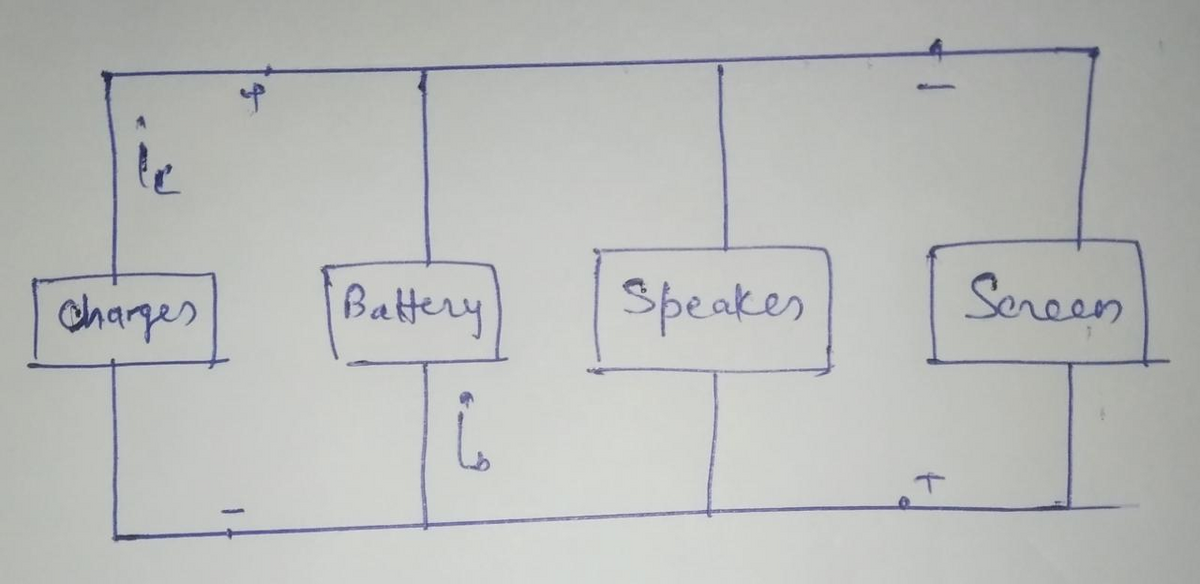The components of a cell phone are shown in the diagram below. Assume that the charge carriers are electrons. a) Find the power absorbed by the battery at t = 3[ms]. b) Find the energy delivered by the charger during the third [millisecond], counting [milliseconds] starting at t = 0. c) Determine whether the electrons flowing through the charger at t = 3[ms] are gaining or losing energy. Explain your answer. ic ISPR
The components of a cell phone are shown in the diagram below. Assume that the charge carriers are electrons. a) Find the power absorbed by the battery at t = 3[ms]. b) Find the energy delivered by the charger during the third [millisecond], counting [milliseconds] starting at t = 0. c) Determine whether the electrons flowing through the charger at t = 3[ms] are gaining or losing energy. Explain your answer. ic ISPR
Introductory Circuit Analysis (13th Edition)
13th Edition
ISBN:9780133923605
Author:Robert L. Boylestad
Publisher:Robert L. Boylestad
Chapter1: Introduction
Section: Chapter Questions
Problem 1P: Visit your local library (at school or home) and describe the extent to which it provides literature...
Related questions
Question
can someone help me with this problem and explain the answer step by step
![AutoSave O Off
ECE2300_Quiz1_Spring2015 (1) - Protected View · Saved to this PC -
P Search (Alt+Q)
abdul asif
AA
File
Home
Insert
Draw
Design
Layout
References
Mailings
Review
View
Help
A Share
P Comments v
The components of a cell phone are shown in the diagram below. Assume
that the charge carriers are electrons.
a) Find the power absorbed by the battery at t = 3[ms].
b) Find the energy delivered by the charger during the third [millisecond],
counting [milliseconds] starting at t = 0.
c) Determine whether the electrons flowing through the charger at t = 3[ms]
are gaining or losing energy. Explain your answer.
Charger
Battery
Speaker
VCHAR
VSCR
Screen
TiscR
Figure 1
VCHAR(t), [V]
ic (mA)
2 4
1.35 -
+: [ms]
10
Figure 3
1.15
+ ; [ms]
10
-17.
2
4
Figure 2
Page 11 of 18
1504 words
Text Predictions: On
DFocus
100%
11:55 AM
O Type here to search
31°F
O O G 4)
2/4/2022](/v2/_next/image?url=https%3A%2F%2Fcontent.bartleby.com%2Fqna-images%2Fquestion%2Fbdd79cd3-887f-44e2-afdb-ed9bc8df797f%2F6e70c510-704b-4774-b4ea-1e7d82f446b8%2Fs0n6aws_processed.png&w=3840&q=75)
Transcribed Image Text:AutoSave O Off
ECE2300_Quiz1_Spring2015 (1) - Protected View · Saved to this PC -
P Search (Alt+Q)
abdul asif
AA
File
Home
Insert
Draw
Design
Layout
References
Mailings
Review
View
Help
A Share
P Comments v
The components of a cell phone are shown in the diagram below. Assume
that the charge carriers are electrons.
a) Find the power absorbed by the battery at t = 3[ms].
b) Find the energy delivered by the charger during the third [millisecond],
counting [milliseconds] starting at t = 0.
c) Determine whether the electrons flowing through the charger at t = 3[ms]
are gaining or losing energy. Explain your answer.
Charger
Battery
Speaker
VCHAR
VSCR
Screen
TiscR
Figure 1
VCHAR(t), [V]
ic (mA)
2 4
1.35 -
+: [ms]
10
Figure 3
1.15
+ ; [ms]
10
-17.
2
4
Figure 2
Page 11 of 18
1504 words
Text Predictions: On
DFocus
100%
11:55 AM
O Type here to search
31°F
O O G 4)
2/4/2022
![AutoSave O Off
ECE2300 Quiz1_Spring2015 (1) - Protected View · Saved to this PC -
P Search (Alt+Q)
abdul asif
AA
File
Home
Insert
Draw
Design
Layout
References
Mailings
Review
View
Help
A Share
P Comments v
TiscR
Figure 1
VCHAR(t), [V]
1.35 +
ic (mA]
2 4
+: [ms]
10
Figure 3
1.15
+, [ms]
2 4
10
-17
Figure 2
is [mA]
7
2
2
++ t, [m s]
10
Figure 4
-11 +
Page 11 of 18
1504 words
Text Predictions: On
D Focus
100%
11:55 AM
O Type here to search
Fz
O O G 4)
W
31°F
2/4/2022
近](/v2/_next/image?url=https%3A%2F%2Fcontent.bartleby.com%2Fqna-images%2Fquestion%2Fbdd79cd3-887f-44e2-afdb-ed9bc8df797f%2F6e70c510-704b-4774-b4ea-1e7d82f446b8%2F6kiz9n8_processed.png&w=3840&q=75)
Transcribed Image Text:AutoSave O Off
ECE2300 Quiz1_Spring2015 (1) - Protected View · Saved to this PC -
P Search (Alt+Q)
abdul asif
AA
File
Home
Insert
Draw
Design
Layout
References
Mailings
Review
View
Help
A Share
P Comments v
TiscR
Figure 1
VCHAR(t), [V]
1.35 +
ic (mA]
2 4
+: [ms]
10
Figure 3
1.15
+, [ms]
2 4
10
-17
Figure 2
is [mA]
7
2
2
++ t, [m s]
10
Figure 4
-11 +
Page 11 of 18
1504 words
Text Predictions: On
D Focus
100%
11:55 AM
O Type here to search
Fz
O O G 4)
W
31°F
2/4/2022
近
Expert Solution
Step 1
The block diagram of a cell phone with its components is shown below,

Here, the charge carriers are the electrons.
Trending now
This is a popular solution!
Step by step
Solved in 7 steps with 3 images

Knowledge Booster
Learn more about
Need a deep-dive on the concept behind this application? Look no further. Learn more about this topic, electrical-engineering and related others by exploring similar questions and additional content below.Recommended textbooks for you

Introductory Circuit Analysis (13th Edition)
Electrical Engineering
ISBN:
9780133923605
Author:
Robert L. Boylestad
Publisher:
PEARSON

Delmar's Standard Textbook Of Electricity
Electrical Engineering
ISBN:
9781337900348
Author:
Stephen L. Herman
Publisher:
Cengage Learning

Programmable Logic Controllers
Electrical Engineering
ISBN:
9780073373843
Author:
Frank D. Petruzella
Publisher:
McGraw-Hill Education

Introductory Circuit Analysis (13th Edition)
Electrical Engineering
ISBN:
9780133923605
Author:
Robert L. Boylestad
Publisher:
PEARSON

Delmar's Standard Textbook Of Electricity
Electrical Engineering
ISBN:
9781337900348
Author:
Stephen L. Herman
Publisher:
Cengage Learning

Programmable Logic Controllers
Electrical Engineering
ISBN:
9780073373843
Author:
Frank D. Petruzella
Publisher:
McGraw-Hill Education

Fundamentals of Electric Circuits
Electrical Engineering
ISBN:
9780078028229
Author:
Charles K Alexander, Matthew Sadiku
Publisher:
McGraw-Hill Education

Electric Circuits. (11th Edition)
Electrical Engineering
ISBN:
9780134746968
Author:
James W. Nilsson, Susan Riedel
Publisher:
PEARSON

Engineering Electromagnetics
Electrical Engineering
ISBN:
9780078028151
Author:
Hayt, William H. (william Hart), Jr, BUCK, John A.
Publisher:
Mcgraw-hill Education,